Assessment of Terra/Aqua MODIS and Deep Convective Cloud Albedo Solar Calibration Accuracies and Stabilities Using Lunar Calibrated MERBE Results
Abstract
:1. Introduction
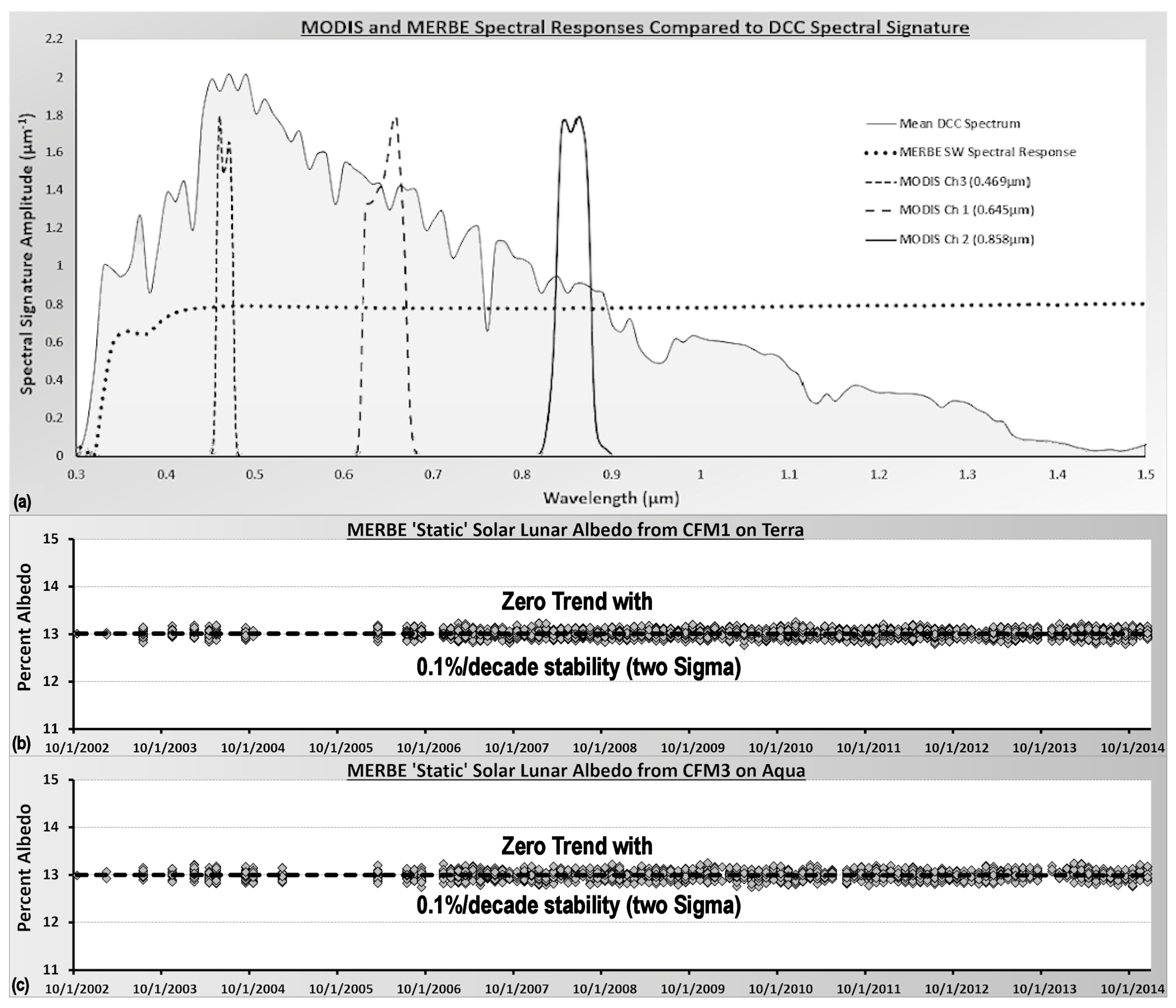
MERBE
2. MERBE SW Comparisons to MODIS Solar Channels 1–3
2.1. Methods
2.2. Data and Results
3. MERBE Assessment of DCC Target Albedo Stability and Accuracy for Solar Calibration, Based on the Moon
3.1. Methods
3.2. Data and Results
4. Summary, Conclusions and Future Work
Funding
Acknowledgments
Conflicts of Interest
References
- NASA. MODIS Brochure; NASA GSFC. 2018. Available online: http://modis.gsfc.nasa.gov/about/media/modis_brochure.pdf (accessed on 12 April 2022).
- Ramanathan, V.; Cess, R.D.; Harrison, E.F.; Minnis, P.; Barkstrom, B.R.; Ahmad, E.; Hartmann, D. Cloud-Radiative Forcing and Climate: Results from the Earth Radiation Budget Experiment. Science 1989, 243, 57–63. [Google Scholar] [CrossRef] [PubMed] [Green Version]
- Fox, N.; Kaiser-Weiss, A.; Schmutz, W.; Thome, K.; Young, D.; Wielicki, B.A.; Winkler, R.; Woolliams, E. Accurate radiometry from space: An essential tool for climate studies. Phil. Trans. R. Soc. A 2011, 369, 4028–4063. [Google Scholar] [CrossRef] [PubMed] [Green Version]
- Wielicki, B.A.; Mlynczak, M.G.; Thome, K.; Leroy, S.; Corliss, J.; Anderson, J.G.; Ao, C.O.; Bantges, R.; Best, F.; Bowman, K.; et al. Achieving Climate Change Absolute Accuracy in Orbit. Bull. Am. Meteorol. Soc. 2013, 94, 1519–1539. [Google Scholar] [CrossRef] [Green Version]
- NASA. Earth Observing System Terra, Aqua and NPP; NASA. 2021. Available online: https://eospso.nasa.gov/current-missions (accessed on 12 April 2022).
- Wielicki, B.A.; Barkstrom, B.R.; Harrison, E.F.; Lee, R.B.; Smith, G.L.; Cooper, J.E. Clouds and the Earth’s Radiant Energy System (CERES): An Earth Observing Experiment. Bull. Am. Meteorol. Soc. 1996, 77, 853–868. [Google Scholar] [CrossRef] [Green Version]
- Wielicki, B.A.; Wong, T.M.; Loeb, N.G.; Minnis, P.; Priestley, K.; Kandel, R. Changes in Earth’s albedo measured by satellite. Science 2005, 308, 825. [Google Scholar] [CrossRef]
- Matthews, G. In-Flight Spectral Characterization and Calibration Stability Estimates for the Clouds and the Earths Radiant Energy System (CERES). J. Atmos. Ocean. Technol. 2009, 26, 1685–1716. [Google Scholar] [CrossRef]
- Dewitte, S.; Clerbaux, N.; Cornelis, J. Decadal Changes of the Reflected Solar Radiation and the Earth Energy Imbalance. Remote Sens. 2019, 11, 663. [Google Scholar] [CrossRef] [Green Version]
- Matthews, G. Real-time Determination of Earth Radiation Budget Spectral Signatures for Non-Linear Un-filtering of Results from MERBE. J. Appl. Meteorol. Climatol. 2018, 57, 273–294. [Google Scholar] [CrossRef]
- Matthews, G. NASA CERES Spurious Calibration Drifts Corrected by Lunar Scans to Show the Sun is not Increasing Global Warming and allow Immediate CRF detection. J. Geophys. Res. 2021, 48, e2021GL092994. [Google Scholar] [CrossRef]
- Dewitte, S.; Nevens, S. The total solar irradiance climate data record. Astrophys. J. 2016, 830, 25. [Google Scholar] [CrossRef]
- Sun, J.; Xiong, X.; Barnes, W.L. MODIS solar diffuser stability monitor sun view modeling. IEEE Trans. Geosci. Remote Sens. 2005, 43, 1845–1854. [Google Scholar]
- Xiong, X.; Angal, A.; Choi, T.; Sun, J.; Johnson, E. On-orbit performance of MODIS solar diffuser stability monitor. J. Appl. Remote Sens. 2014, 8, 083514. [Google Scholar] [CrossRef] [Green Version]
- Chen, H.; Wang, Z.; Sun, J.; Angal, A.; Xiong, X. Recent progress of MODIS solar diffuser on-orbit degradation characterization. In Proceedings of the SPIE Optical Engineering + Applications, San Diego, CA, USA, 12–16 August 2012. [Google Scholar]
- Lee, S.; Meister, G. MODIS solar diffuser degradation determination and its spectral dependency. In Proceedings of the SPIE Optical Engineering + Applications, San Diego, CA, USA, 19–23 August 2018. [Google Scholar]
- NRC. Earth Science and Applications from Space: National Imperatives for the Next, Decade and Beyond (2007); National Research Council. 2007. Available online: https://www.nap.edu/catalog/11820/earth-science-and-applications-from-space-national-imperatives-for-the (accessed on 12 April 2022).
- Xiong, X.; Angal, A.; Chang, T.; Chiang, K.; Lei, N.; Li, Y.; Sun, J.; Twedt, K.; Wu, A. MODIS and VIIRS Calibration and Characterization in Support of Producing Long-Term High-Quality Data Products. Remote Sens. 2019, 12, 3167. [Google Scholar] [CrossRef]
- Priestley, K.J.; Barkstrom, B.R.; Lee, R.B.; Green, R.N.; Thomas, S.; Wilson, R.S.; Spence, P.L.; Paden, J.; Pandey, D.K.; Al-Hajjah, A. Postlaunch Radiometric Validation of the Clouds and the Earth’s Radiant Energy System (CERES) Proto-Flight Model on the Tropical Rainfall Measuring Mission (TRMM) Spacecraft through 1999. J. Appl. Meteorol. 2000, 39, 2249–2258. [Google Scholar] [CrossRef]
- Loeb, N.G.; Wielicki, B.A.; Su, W.; Loukachine, K.; Sun, W.; Wong, T.M.; Priestley, K.; Matthews, G.; Miller, W.F.; Davies, R. Multi-Instrument Comparison of Top-of-Atmosphere Reflected Solar Radiation. J. Clim. 2007, 20, 575–591. [Google Scholar] [CrossRef]
- Priestley, K.J.; Smith, G.L.; Thomas, S.; Cooper, D.; Lee, R.B.; Walikainen, D.; Hess, P.; Szewczyk, Z.P.; Wilson, R. Radiometric Performance of the CERES Earth Radiation Budget Climate Record Sensors on the EOS Aqua and Terra Spacecraft through April 2007. J. Atmos. Ocean. Technol. 2011, 28, 3–21. [Google Scholar] [CrossRef]
- NRC. Earth Science and Applications from Space: National Imperatives for the Next, Decade and Beyond (2017); National Research Council. 2017. Available online: https://sites.nationalacademies.org/DEPS/ESAS2017/index.htm (accessed on 12 April 2022).
- Matthews, G. First Decadal Lunar Results from the Moon and Earth Radiation Budget Experiment (MERBE). Appl. Opt. 2018, 57, 1594–1610. [Google Scholar] [CrossRef]
- Hooker, S.B.; Esaias, W.E.; Feldman, G.C.; Gregg, W.W.; McClain, C.R. An Overview of SeaWiFS and Ocean Color; SeaWiFS Technical Report Series, NASA Tech memo 104566; NASA Goddard Space Flight Center: Greenbelt, MD, USA, 1992; Volume 1.
- Barnes, R.A.; Eplee, R.E.; Patt, F.S.; Kieffer, H.H.; Stone, T.C.; Meister, G.; Butler, J.J.; McClain, C.R. Comparison of SeaWiFS Measurements of the Moon with the U.S. Geological Survey Lunar Model. Appl. Opt. 2004, 43, 5838–5854. [Google Scholar] [CrossRef] [Green Version]
- Sun, J.; Xiong, X.; Angal, A.; Wilson, T. MODIS reflective solar bands lunar calibration update and improvements. In Proceedings of the SPIE Remote Sensing, Online, 21–25 September 2020. [Google Scholar]
- Matthews, G. Celestial body irradiance determination from an under-filled satellite radiometer: Application to albedo and thermal emission measurements of the Moon using CERES. Appl. Opt. 2008, 47, 4981–4993. [Google Scholar] [CrossRef]
- Priestley, K.J.; Thomas, S.; Smith, G.L. Validation of Point Spread Functions of CERES Radiometers by the Use of Lunar Observations. J. Atmos. Ocean. Technol. 2010, 27, 1005–1011. [Google Scholar] [CrossRef]
- Matthews, G. Signal Processing Enhancements to Improve Instantaneous Accuracy of a Scanning Bolometer: Application to MERBE. IEEE Trans. Geosci. Remote Sens. 2018, 56, 3421–3431. [Google Scholar] [CrossRef]
- Daniels, J.L.; Smith, G.L.; Priestley, K.J.; Thomas, S. Using Lunar Observations to Validate In-Flight Calibrations of Clouds and the Earth’s Radiant Energy System Instruments. IEEE Trans. Geosci. Remote Sens. 2015, 53, 5110–5116. [Google Scholar] [CrossRef]
- Kieffer, H.; Stone, T.C. The Spectral Irradiance of the moon. Astron. J. 2005, 129, 2887–2901. [Google Scholar] [CrossRef] [Green Version]
- Minnis, P.; Sun-Mack, S.; Trepte, Q.Z.; Chang, F.; Heck, P.W.; Chen, Y.; Yi, Y.; Arduini, R.F.; Ayers, K.; Bedka, K.; et al. CERES Edition 3 Cloud Retrievals. In Proceedings of the AMS 13th Conference on Atmospheric Radiation, Portland, OR, USA, 27 June–2 July 2010. [Google Scholar]
- Wu, A.; Xiong, X.; Doelling, D.R.; Morstad, D.; Angal, A.; Bhatt, R. Characterization of Terra and Aqua MODIS VIS, NIR, and SWIR Spectral Bands’ Calibration Stability. IEEE Trans. Geosci. Remote Sens. 2013, 51, 4330–4338. [Google Scholar] [CrossRef]
- Matthews, G. Animation of Real-time MERBE Fourier Series Tensor Spectral Signatures from AQUA for CALCON Conference; Zedika Solutions LLC. 2015. Available online: https://drive.google.com/file/d/1wdSc9pxrDP34l1Ywx2Opd50bS6vyeUrf/view?usp=sharing (accessed on 12 April 2022).
- Goldin, D.; Smith, G.L.; Thomas, S.; Cooper, D.; Lee, R.B.; Walikainen, D.; Hess, P.; Szewczyk, Z.P.; Wilson, R. CLARREO Pathfinder/VIIRS Intercalibration: Quantifying the Polarization Effects on Reflectance and the Intercalibration Uncertainty. Remote Sens. 2019, 11, 1914. [Google Scholar] [CrossRef] [Green Version]
- Thome, K.; Aytac, Y. Independent calibration approach for the CLARREO Pathfinder Mission. Imaging Spectrom. Xxiii Appl. Sens. Process. 2019, 11130, 111300B. [Google Scholar]
- Chander, G.; Hewison, T.J.; Fox, N.; Wu, X.; Xiong, X.; Blackwell, W.J. Overview of Intercalibration of Satellite Instruments. IEEE Trans. Geosci. Remote Sens. 2013, 51, 1056–1080. [Google Scholar] [CrossRef]
- Doelling, D.R.; Wu, A.; Xiong, X.; Scarino, B.R.; Bhatt, R.; Haney, C.O.; Morstad, D.; Gopalan, A. The Radiometric Stability and Scaling of Collection 6 Terra- and Aqua-MODIS VIS, NIR, and SWIR Spectral Bands. IEEE Trans. Geosci. Remote Sens. 2015, 53, 4520–4535. [Google Scholar] [CrossRef]
- Pangaea. MERBE Ed1.0 Reflected Solar Data Download; Pangaea: Bremen, Germany, 2021. [Google Scholar] [CrossRef]
- Pangaea. MERBE Ed1.1 Incoming Solar Data Download; Pangaea: Bremen, Germany, 2021. [Google Scholar] [CrossRef]

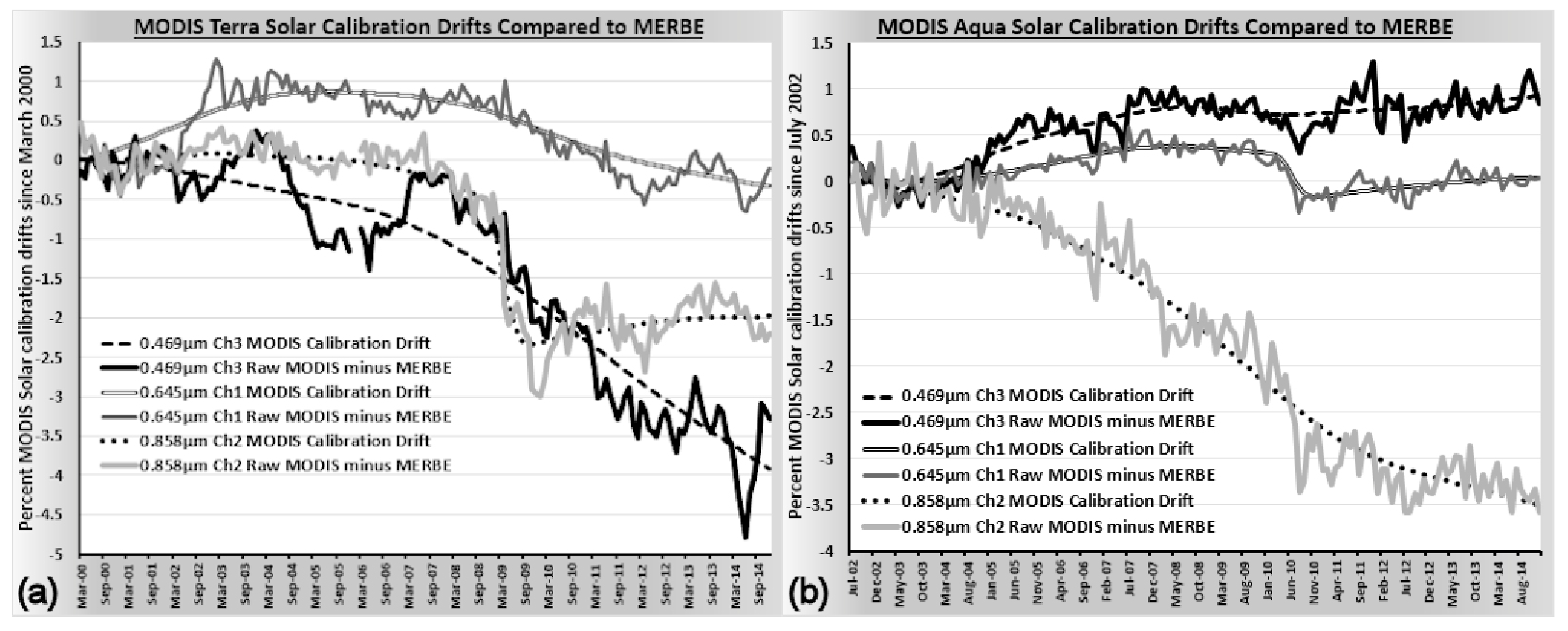
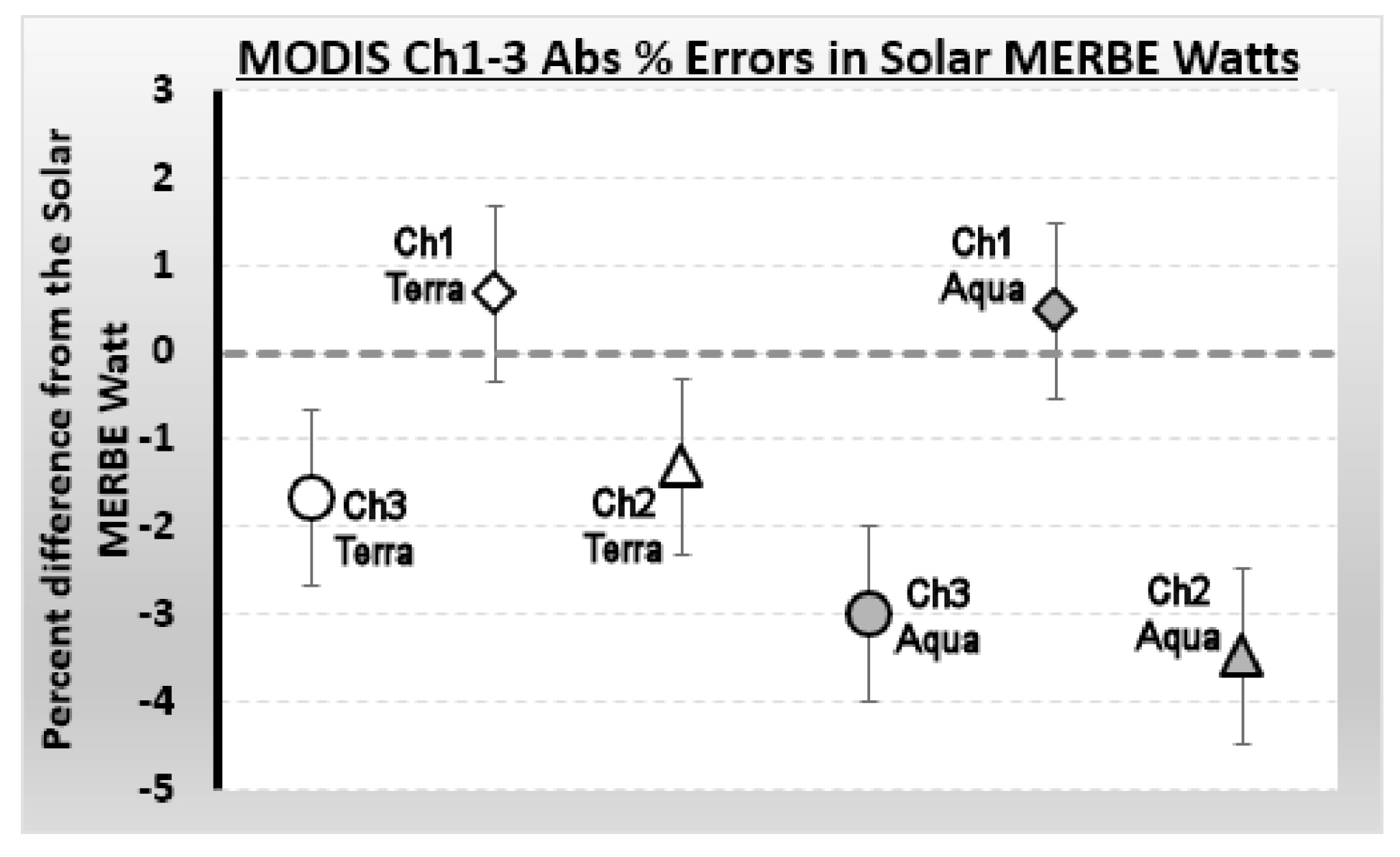
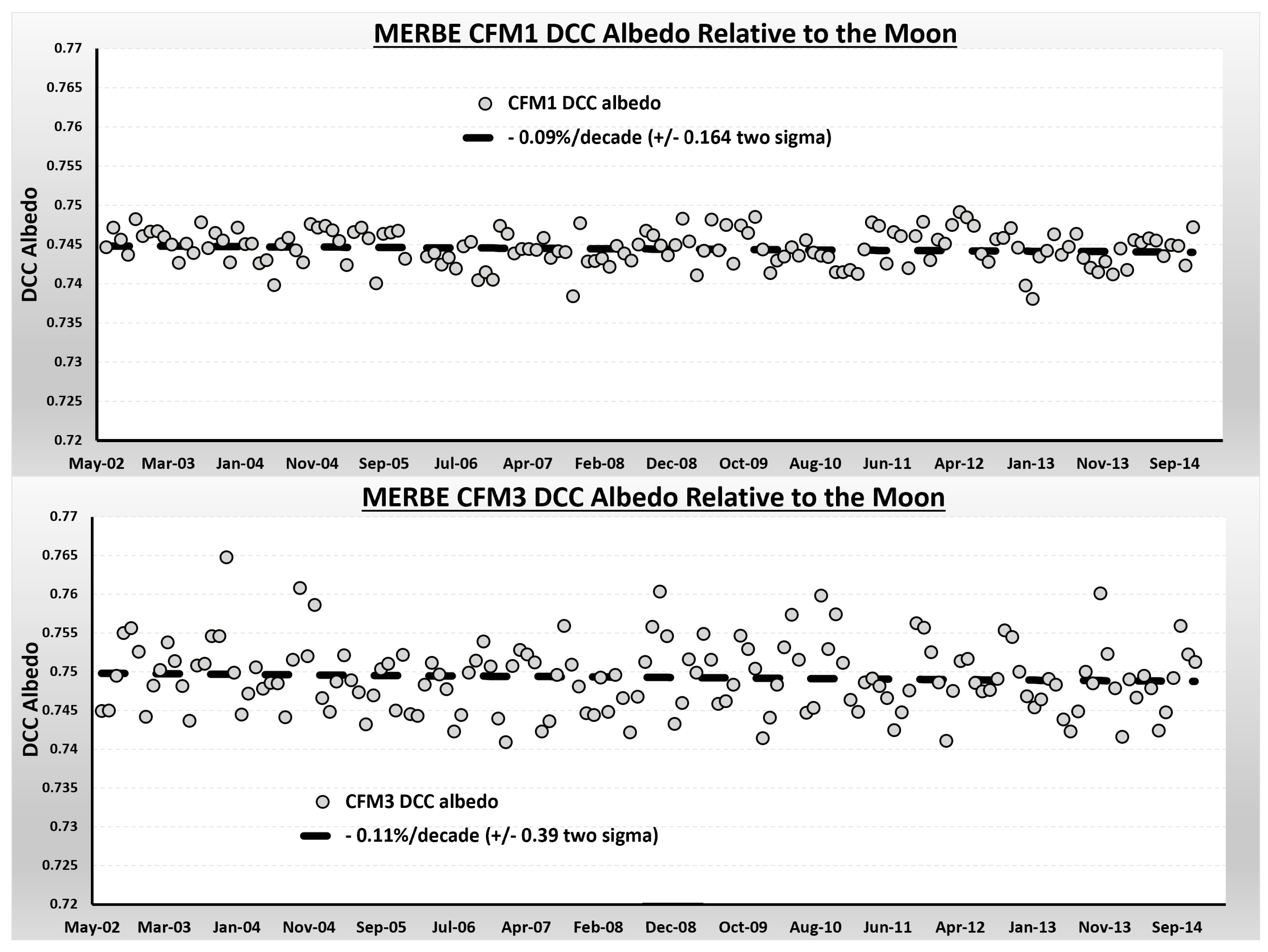
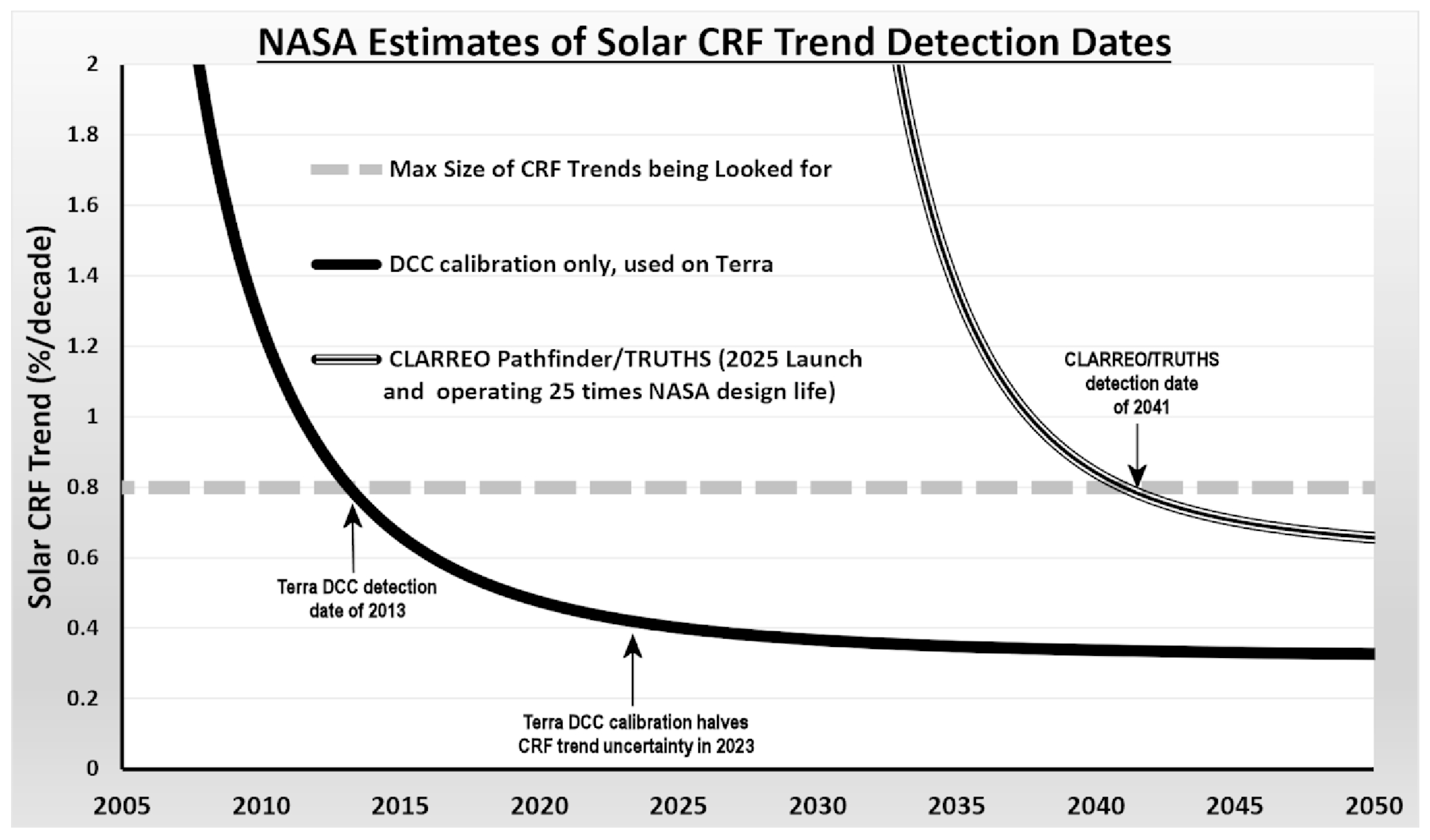
Publisher’s Note: MDPI stays neutral with regard to jurisdictional claims in published maps and institutional affiliations. |
© 2022 by the author. Licensee MDPI, Basel, Switzerland. This article is an open access article distributed under the terms and conditions of the Creative Commons Attribution (CC BY) license (https://creativecommons.org/licenses/by/4.0/).
Share and Cite
Matthews, G. Assessment of Terra/Aqua MODIS and Deep Convective Cloud Albedo Solar Calibration Accuracies and Stabilities Using Lunar Calibrated MERBE Results. Remote Sens. 2022, 14, 2517. https://doi.org/10.3390/rs14112517
Matthews G. Assessment of Terra/Aqua MODIS and Deep Convective Cloud Albedo Solar Calibration Accuracies and Stabilities Using Lunar Calibrated MERBE Results. Remote Sensing. 2022; 14(11):2517. https://doi.org/10.3390/rs14112517
Chicago/Turabian StyleMatthews, Grant. 2022. "Assessment of Terra/Aqua MODIS and Deep Convective Cloud Albedo Solar Calibration Accuracies and Stabilities Using Lunar Calibrated MERBE Results" Remote Sensing 14, no. 11: 2517. https://doi.org/10.3390/rs14112517
APA StyleMatthews, G. (2022). Assessment of Terra/Aqua MODIS and Deep Convective Cloud Albedo Solar Calibration Accuracies and Stabilities Using Lunar Calibrated MERBE Results. Remote Sensing, 14(11), 2517. https://doi.org/10.3390/rs14112517





